Sponsored By
ROCK
HARDWARE
[ More Interviews | Tick List ]
Date:
12th May 2003
Intro: Local Melbourne based climber Martin Lama has an impressive
climbing résumé. Literally! He's onsighted grade 27 and made quick ascents
of 28’s. He's won several local climbing and bouldering competitions, was
ranked 2nd with the Australian Sport Climbing Federation during 1997 & 98
and has competed in the World Cup and US Nationals. He's ticked 28 in Volx,
France, spirited up 27's in diverse parts of the US, such as Smith Rock,
Jailhouse Rock, Cave Rock, Rifle, Enchanted Towers, and so on. He's
bouldered up to V9 in Hueco Tanks, Texas, Fontainebleau, France and
Berchtesgaden, Germany. He's fired off many our local Arapiles classics
such as "India", "Ciela" at grade 28, and "Tunnel To Caracus" in the
Gramps also at 28, and countless others. Currently Martin is training for
triathlons more than climbing, due to persistent elbow problems, but still
gets out on the rocks to boulder when time permits. He has a Bachelor of
Applied Science in Computing and Mathematical Sciences, works as a system
tester, speaks three languages and tries to play the guitar when the surfs
not up.
Right: Martin catches the sloping crux hold of this first ascent on
the summit of the Sugarloaf, Catherdral Ranges, Victoria. (Photo by Neil
Monteith).
Q: Lets start at the
beginning. When did you first get into climbing? Was there a particular
person or event that started the ball rolling?
There is an old limestone quarry in the
monastery five minutes from where I grew up and it just felt natural
climbing the walls there. I then borrowed all the libraries books on
climbing I could find, especially one ‘Yosemite Climber’. It’s an old
coffee table photo book with many pictures and stories of climbing in the
valley, which gave me inspiration and direction.
Q: I believe that
after Uni you worked for the next eight years at the Melbourne climbing
gym Hardrock to focus your life on climbing. I assume it was this
dedication to the sport that brought about the impressive tick list and
competition results? What sort of hours per week were you devoting to
climbing back then? Was your motivation always enthusiastic?
I had a singular focus to climbing in those
days. Depending what I was training for, many days involved 5 to 6 hour
bouldering or climbing sessions. Motivation was always provided by either
setting goals or having trips / events planned.
Q: You've
climbed a lot overseas, including France, and the US. How does the
climbing scene compare to that of Australia?
Europe has the friendliest and supportive scene.
With the huge number of climbers, it fosters a strong community where
there is no real division between different styles of climbing - such as
sport versus traditional climbing. This negative aspect is still prevalent
in Australia and still to a lesser degree in the states. People should
realize that all climbing styles complement each other with none better
than another.
Q: Any
particular overseas climbing destinations that you'd definitely recommend,
in terms of ease of access, quality of routes, hospitality of locals,
scenery, etc?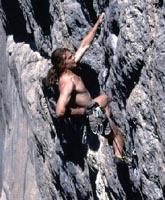
I recommend all climbers to travel outside their
local area. To be exposed to other cultures, different rock types and
styles.
My favourites -
Climbing:
- France - Buoux near Apt for classics of all grades and Ceuse for immaculate alpine limestone
- USA – Rifle in Colorado for steep limestone in a beautiful canyon.
Bouldering:
- France – Fontainebleau, a magical forest one hour south of Paris. The birthplace of modern bouldering with amazing problems.
- USA - Hueco Tanks, a brilliant area now though spoilt by government bureaucracy.
Above Right: Medicine Douce 6C+ Ceuse France. One of the warm ups at the right end of the cascade sector.
Q: I noticed you
put ticking a route called "20 Ans Apres" (28) on your 2nd try in Volx,
France during 1997, top of your list of climbing achievements. What stands
out about this climb above the others in your mind?
20 Ans Apres is listed at the top of my climbing
achievements only because of the speed of the ascent at the grade.
Probably my hardest onsights would be my more memorable ascents on routes.
Q: I notice
you've done a lot of 27's and a couple of 28's at Arapiles and the
Grampains. For the local readers, can you describe one of those climbs?
Such as "India" (28) at Mt Arapiles.
India has a lot of history as a climb, which has
been one facet in selecting the routes I try. The climbing sadly doesn’t
measure up. As with many harder climbs at Mt Arapiles, India involves a
short crux section and easier climbing. A grade 18 crack initially, then
long, enjoyable delicate moves at around 24-25 to double underclings below
the crux. Powerful sharp right hand gaston, left to a matchstick edge with
a good thumb catch, foot up and throw for the fingerlock with the left.
The left hand heel hook would have to be one of the better known images of
this climb. A couple long moves lead to a knee bar rest, and then an easy
traverse right and up the wide crack is all that’s left before the
anchors.
Q: You climbed
“India” for the climbing video "Low
Gravity". What was it like being part of the “commercial video”
experience?
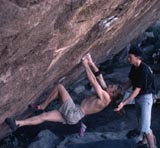
The video ‘Low Gravity” hasn’t had the most
favourable reviews. I will be the first to admit that it could have
benefited from tighter editing and a better sound track. But when you saw
the phenomenal effort John put into this video. Hitch hiking across
Australia, camera in hand to document climbing in Australia at that time.
I was glad to be included in his project.
Right: Double Boiler V8 45 degree wall Hueco
Tanks. Texas USA Jan 98.
Q: I see you
flashed "Power Corruption & Lies" (27) at Arapiles and "Satanic Verses via
the direct finish" (27) at Camels Hump back in early 1994. That's
impressive indeed. You must have been on fire during that period. How did
it feel?
Although physical training is important,
climbing is mostly mental. The mental breakthrough came the year prior
when I did my first 26 (The Fortress at Mt Arapiles) and then dispatched
my first 27 just as easily (Angular Perspective – original finish 2nd
try). It was then the realization and belief in what I could do and the
rest followed.
Q: A review of
any guidebook to Victoria tends to show a number of new routes you have
climbed, including many sporty routes in the mid 20's. You would appear to
have been more active at the smaller regional crags around Melbourne than
at the "big 3" climbing areas in the state. Is this a fair comment, and if
so why?
People think that working in a gym is ideal.
Getting paid to do what you enjoy. But what ends up happening because of
the pay, is that you need to take any shifts offered. So it’s hard to
organize and get away with others for longer trips. Therefore you are
forced to head out to the local crags for day trips.
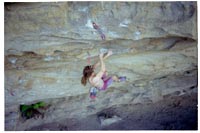 Q:
Of the new routes you have put up, what is your personal favourite, and
why?
Q:
Of the new routes you have put up, what is your personal favourite, and
why?
I would have to say ‘Skulthuggery’ at Bundaleer.
It follows the line of least resistance through the left side of the
camping cave, which has only three routes - one being the classic Angular
Perspective.
Right: Skulthuggery (26), Bundaleer, 1st
ascent.
Q: Are you/were you
into working projects? Picking a hard route at or above your limit,
camping at its base and working each move over and over, until you can
tick the line? Or are you more likely to try a few times, and failing,
leave it for another trip?
I always preferred onsighting routes for it’s
intensity of reading sequences, making decisions and moves quickly and
with precision. It also helped with the focus and mental preparation for
competitions. I did spend time working harder climbs, but I preferred
doing five climbs in one day say versus five days on one climb. Especially
when on the road overseas.
Q: You've
competed in dozens of indoor climbing and bouldering competitions
Nationally and Internationally. I would assume that many of us are unaware
that this avenue to the sport even exists. I know I've never witnessed a
comp. Can you give us something of a run down on how these things
typically proceed? How scores are kept, the feeling and pressures of the
comp as it builds towards a conclusion.
Onsight climbing competitions usually consist of
a qualifier and final. The qualifier is ideally set at a difficulty that
allows a percentage of competitors to top out and go through to the final.
Scores are based on height gained, not time. For the final, the routes are
ideally set to have people fall at various moves up with one climber
hopefully toping out.
Bouldering competitions are usually less formal and results are decided on
a cumulative score for the hardest say 10 problems completed within a set
time. This totalled score is the final result or used as a qualification
for a final.
Competitions are great training for controlling arousal levels for
climbing outdoors. The same feelings and emotions need to be controlled
before a difficult onsight or redpoint, as much as for a competition.
Q: When you
were performing extremely well on the competition climbing tour in the mid
to late 90's, was it possible to support yourself on the income you
received from prize money (if any)?
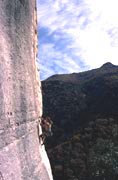
Not in Australia. The competition scene is still
too small, and the prizes were usually climbing products rather than cash.
I was fortunate to have a sponsor who helped with travel expenses and
accommodation for competing, but I still needed to earn a wage to get by
and fund my trips.
Right: No Mans Land 7B Buoux France 97.
Q: Now the
inevitable training question, for all us wanna be harder types. When you
were climbing at your peak, did you follow a training system, and if so
can you describe it?
It would take too long to put in detail for the
interview. I can put together a training article, which describes training
fundamentals if you like. [Editor: We'll certainly ask Martin about this!]
Q: Do you use
a different training system for indoor competitions as opposed to working
up to a difficult outdoor lead?
Training varied more based on the type of
climbing rather than whether it was indoors or outdoors. Power for
bouldering and endurance for routes. Although training on plastic does
help with competing on plastic.
Q: Did you
have any weakness in your climbing? Cracks, off-widths, run out trad, that
kind of thing?
My crack climbing skills still have a lot to be
desired.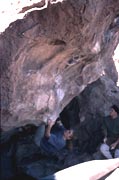
Q: Ever
thought of expanding your free climbing into mountaineering?
The scenery is amazing, but it looks too much
like hard work!
Right: Crash Dummies V7 Hueco Tanks 97.
Q: You
officially "retired" from climbing in 98 due to reoccurring bouts of
tendonitis in both elbows. That must have been devastating, given the good
results you were achieving in climbing at the time. Are you philosophical
about the injuries, or do you have some regrets?
At the time of the second and worse reoccurrence
where it was now both elbows, the realization that I wouldn’t be able to
continue was devastating. As any driven athlete, my world revolved around
my sport. I had always seen myself travelling and climbing. It was very
hard at first, especially still working in the gym. Since though, I have
now come to terms with my injuries and am climbing accordingly.
My only regret climbing would have to be not climbing to my potential in
regards to harder ascents. There a few climbs I had tried that I would
like to have gone back to and completed.
Q: Do you feel
that there was something specific about your training systems that lead
directly to your tendonitis? Do you have any advice to offer on how to
avoid overuse injuries?
I discovered the magical and addictive qualities
of campus training after I built a free standing campus board in my house.
Even after many years of hard training, campusing produced immediate huge
gains in strength. The intensity of the training was also addictive. Here
was a training tool that reduced training sessions from at least six hours
to two. So instead of one session a week, it became two, then three.
Because of the greater chance for injury, I wouldn’t recommend campusing
to many people, and then only in the foundation phase of your macrocycle.
- To avoid injury, the number one rule is learn to listen to your body and take heed.
- If a training method gives huge instant gains - be wary.
- Train antagonistic muscles (opposite muscles so neither side is too dominant).
- Stretch - longer muscles tend not to be as easily injured.
Q: Your current
triathlon training obviously involves a lot of swimming, running and
biking for several hours each day. I'd be interested to know if this
"cross training", has actually helped your climbing or hindered it. (Elbow
injuries aside).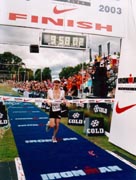
Training for Ironman triathlons is mostly
aerobic, whereas climbing fitness is very specific and predominately
anaerobic, so is of no major benefit. Easy aerobic work though does have
recuperative benefits for climbing. It forces fresh blood through muscles
helping flush out lactic acid and by burning calories it helps with weight
management.
Right: Finish at Ironman New Zealand 2003.
Q: What would
you recommend to climbers looking to push into harder levels?
Training your weakest link will make the biggest
gains.
Q: Which do
you prefer most, bouldering, sport climbing, trad climbing? Indoors vs
Outdoors? New routing? Competitions?
Bouldering always held the greatest interest to
me. Cutting back all the superfluous bits in climbing to focus on the most
difficult move you can physically do.
Q: Time for a
few generic questions, do you have a favourite crag or climb in Victoria?
Although overrun these days and not in vogue as
the Grampians, Mt Arapiles still offers many classics of all grades. As
for climbs, there are too many to narrow down to one most favourite.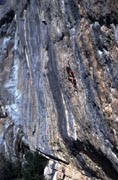
Q: Do you have
a climbing hero/heroine?
Wolfgang Gullich was definitely a hero. He
pushed the levels of difficulty throughout the world. (see:
link). But more
importantly, from interviews with people who met him, he seemed a really
sincere and kind person first and foremost.
Right: Martin on Blanche Fesse 7C Cascade Sector Ceuse France 97.
Q: From a
philosophical standpoint what did climbing bring to your life? (Fitness,
friends, challenge, adventure..?)
Climbing bought all of the above into my life.
The places, people and experiences were worth all the sacrifices made over
the years. Climbing would have to be one of the most unique past times
around.
Q: And what
about the future? Any projects you're working on, trips planned?
Free time is now harder to come by. With
training, work and wife commitments. I still have bolted projects around
the place, boulder problems still waiting an FA and other lines scoped. So
once I get around to rebuilding my woodie, I may get around to finishing
off some of these hopefully.
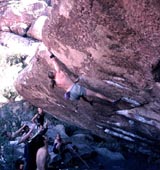
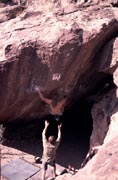
Above Left: The 45 Degree Wall V5 Hueco Tanks 98
would have to rank as one of the best boulder problems in the world.
Easiest line up the middle of the wall. Commiting crux dyno to the dish at
the lip. Above Right: Dragon Fly V5 another moderate classic at
Hueco.
Home | Guide | Gallery | Tech Tips | Articles | Reviews | Dictionary | Forum | Links | About | Search
Chockstone Photography | Landscape Photography Australia | Australian Landscape Photography
Please read the full disclaimer before using any information contained on these pages.
All text, images and video on this site are copyright. Unauthorised use is strictly prohibited.
